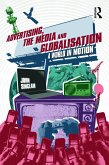Georgia-Zozeta Miliopoulou
Creative Advertising Concept and Copy
A Practical, Multidisciplinary Approach
Georgia-Zozeta Miliopoulou
Creative Advertising Concept and Copy
A Practical, Multidisciplinary Approach
- Gebundenes Buch
- Merkliste
- Auf die Merkliste
- Bewerten Bewerten
- Teilen
- Produkt teilen
- Produkterinnerung
- Produkterinnerung
Considering perspectives on creative advertising through a unique media and communications lens, this book encompasses both the theory and practical tools needed to approach and understand creativity in advertising with an original eye.
Andere Kunden interessierten sich auch für
![Principles of Strategic Communication Principles of Strategic Communication]() Derina HoltzhausenPrinciples of Strategic Communication207,99 €
Derina HoltzhausenPrinciples of Strategic Communication207,99 €![Masters of Advertising Copy (RLE Marketing) Masters of Advertising Copy (RLE Marketing)]() Masters of Advertising Copy (RLE Marketing)66,99 €
Masters of Advertising Copy (RLE Marketing)66,99 €![Industrial Advertising Copy (RLE Marketing) Industrial Advertising Copy (RLE Marketing)]() R. Bigelow LockwoodIndustrial Advertising Copy (RLE Marketing)63,99 €
R. Bigelow LockwoodIndustrial Advertising Copy (RLE Marketing)63,99 €![Integrated Marketing Communication Integrated Marketing Communication]() Robyn BlakemanIntegrated Marketing Communication121,99 €
Robyn BlakemanIntegrated Marketing Communication121,99 €![Advertising, the Media and Globalisation Advertising, the Media and Globalisation]() John SinclairAdvertising, the Media and Globalisation54,99 €
John SinclairAdvertising, the Media and Globalisation54,99 €![Brands of Faith Brands of Faith]() Mara EinsteinBrands of Faith57,99 €
Mara EinsteinBrands of Faith57,99 €![The Social Organisation of Marketing The Social Organisation of Marketing]() The Social Organisation of Marketing90,99 €
The Social Organisation of Marketing90,99 €-
-
-
Considering perspectives on creative advertising through a unique media and communications lens, this book encompasses both the theory and practical tools needed to approach and understand creativity in advertising with an original eye.
Hinweis: Dieser Artikel kann nur an eine deutsche Lieferadresse ausgeliefert werden.
Hinweis: Dieser Artikel kann nur an eine deutsche Lieferadresse ausgeliefert werden.
Produktdetails
- Produktdetails
- Verlag: Routledge
- Seitenzahl: 222
- Erscheinungstermin: 8. April 2024
- Englisch
- Abmessung: 240mm x 161mm x 17mm
- Gewicht: 502g
- ISBN-13: 9781032357959
- ISBN-10: 1032357959
- Artikelnr.: 69483273
- Herstellerkennzeichnung
- Libri GmbH
- Europaallee 1
- 36244 Bad Hersfeld
- gpsr@libri.de
- Verlag: Routledge
- Seitenzahl: 222
- Erscheinungstermin: 8. April 2024
- Englisch
- Abmessung: 240mm x 161mm x 17mm
- Gewicht: 502g
- ISBN-13: 9781032357959
- ISBN-10: 1032357959
- Artikelnr.: 69483273
- Herstellerkennzeichnung
- Libri GmbH
- Europaallee 1
- 36244 Bad Hersfeld
- gpsr@libri.de
Georgia-Zozeta Miliopoulou is Associate Professor in the Department of Communication at Deree, The American College of Greece. She has over 25 years of experience in creative advertising and holds a Ph.D. in brand communication. She has been teaching creative advertising and new media since 2003 and still offers workshops for communication professionals. Her research interests include creativity, strategic content & storytelling, and the managerial aspects of creative agency work.
About the author
Preface
Acknowledgements
1. Advertising: bridging the economic and social sphere
1.1 Advertising studies
1.2 Advertising: definition and scope
1.3 The product and the brand; marketing and advertising.
1.4 The practice of advertising in steps
1.5 The creative brief and the outline of the book - a parallel structure
1.6 What is not in this book.
2. Objectives and effects: What advertising can (and cannot) do - and how
to plan for results
2.1 Introduction
2.2 Think - Feel - Do: How advertising sets its objectives.
2.3 From consumers to brands
2.4 Arriving at sensible and plausible objectives
2.5 Measurements and metrics
2.6 The unintended effects of advertising
2.6.1 Shopping for meaning in the symbolic marketplace.
2.6.2 Who's in, who's out? Advertising representations
3. Audiences and consumers: How people read products and consume ads. How
ads read people.
3.1 How people read products and consume ads
3.2 Basic semiotics
3.2.1 The sign
3.2.2 Denotation & Connotation
3.2.3 The metaphor
3.2.4 Encoding and decoding
3.3 How to read through an ad.
3.4 How ads read people.
3.4.1 STP
3.4.2 Dividing and classifying
3.4.3 The STP challenges
3.5 Tools to understand people.
3.5.1 Customer journeys
3.5.2 Customer personas
3.6 Insights
3.7 The role of big data in creative advertising
4. The creative idea in practice and in theory
4.1 Introduction
4.2 Creativity: a context-specific definition
4.3 Creative advertising: the product
4.4 From an idea to a campaign: elements of synergy & integration
4.5 Creative advertising: the agency process
4.6 Connecting practice to theory.
4.6.1 Divergent and convergent thinking in creative advertising
4.6.2 Fluency, flexibility, originality
4.6.3 Preparation, incubation, illumination, verification
4.7 Creative advertising compared to creative problem solving and design
thinking
4.8 Tools & techniques for advertising creativity - towards a modus
operandi
4.8.1 Automatic writing - free associations
4.8.2 Forced connections
4.8.3 Consumer and brand prompts
4.8.4 SCAMPER
4.8.5 Brainstorming / Brainwriting
4.9 The everyday life and the cliches of the creative advertising
professional
4.9.1 The creative genius and the team
4.9.2 The Ps of creativity in the agency
4.9.3 Soft skills
4.9.4 Deadlines, stress, risks, and incentives
4.9.5 The need for diversity and management
4.9.6 Compartmentalisation
5. Text and image combinations: print, outdoor, post, meme
5.1 Introduction
5.2 Anchoring
5.3 Rhetorical figures
5.3.1 Rhetorical schemes
5.3.2 Rhetorical tropes
5.4 Visual rhetoric and combinational creativity
5.5 Copywriters and art directors in tandem: working in a creative ad
agency
6. Storytelling: creating TV, radio, and video ads
6.1 Introduction
6.2 Narrative theory: a brief overview
6.3 Narrative tools.
6.4 Writing the TV script.
6.5 Types of TV advertising
6.6 Writing for the radio or for podcasts
6.7 Transmedia storytelling and advergames
7. What creatives need to know about media planning
7.1 Introduction
7.2 Paid, owned, earned media
7.3 Media planning in traditional media - key terms
7.4 Media planning in traditional media - selecting the appropriate mix.
7.5 Display ads on the web and social media
7.6 A few words on programmatic advertising.
7.7 A few words on social media advertising
7.8 Conversions and connections
7.9 Integrated and omnichannel campaigns.
7.10 Local, global, glocal - in the context of new media
7.11 Creative use of media
8. Content Marketing:
8.1 Branded content and content marketing
8.2 Engaging through content: three approaches
8.3 Content marketing & product category
8.4 Content strategy and planning in steps
8.5 Branded content - pillars & formats
8.6 Content calendars
8.7 Metrics & KPIs
8.8 A few words on virality
8.9 Is the King dead?
8.10 "OK, Boomer"
9. Ethics & regulations in advertising
9.1 Introduction
9.2 Self-regulation in a nutshell
9.3 Some key ethical issues.
9.3.1 Product category related regulations.
9.3.2 Advertising regulations across categories
9.4 Improving one ad at a time: the message and the claim.
9.5 Considering ads as a whole - Some key issues.
9.6 Power relations between brands and consumers.
9.7 Considering ads as a whole: your moral compass
9.8 Normative ethics and deontology
Index
Preface
Acknowledgements
1. Advertising: bridging the economic and social sphere
1.1 Advertising studies
1.2 Advertising: definition and scope
1.3 The product and the brand; marketing and advertising.
1.4 The practice of advertising in steps
1.5 The creative brief and the outline of the book - a parallel structure
1.6 What is not in this book.
2. Objectives and effects: What advertising can (and cannot) do - and how
to plan for results
2.1 Introduction
2.2 Think - Feel - Do: How advertising sets its objectives.
2.3 From consumers to brands
2.4 Arriving at sensible and plausible objectives
2.5 Measurements and metrics
2.6 The unintended effects of advertising
2.6.1 Shopping for meaning in the symbolic marketplace.
2.6.2 Who's in, who's out? Advertising representations
3. Audiences and consumers: How people read products and consume ads. How
ads read people.
3.1 How people read products and consume ads
3.2 Basic semiotics
3.2.1 The sign
3.2.2 Denotation & Connotation
3.2.3 The metaphor
3.2.4 Encoding and decoding
3.3 How to read through an ad.
3.4 How ads read people.
3.4.1 STP
3.4.2 Dividing and classifying
3.4.3 The STP challenges
3.5 Tools to understand people.
3.5.1 Customer journeys
3.5.2 Customer personas
3.6 Insights
3.7 The role of big data in creative advertising
4. The creative idea in practice and in theory
4.1 Introduction
4.2 Creativity: a context-specific definition
4.3 Creative advertising: the product
4.4 From an idea to a campaign: elements of synergy & integration
4.5 Creative advertising: the agency process
4.6 Connecting practice to theory.
4.6.1 Divergent and convergent thinking in creative advertising
4.6.2 Fluency, flexibility, originality
4.6.3 Preparation, incubation, illumination, verification
4.7 Creative advertising compared to creative problem solving and design
thinking
4.8 Tools & techniques for advertising creativity - towards a modus
operandi
4.8.1 Automatic writing - free associations
4.8.2 Forced connections
4.8.3 Consumer and brand prompts
4.8.4 SCAMPER
4.8.5 Brainstorming / Brainwriting
4.9 The everyday life and the cliches of the creative advertising
professional
4.9.1 The creative genius and the team
4.9.2 The Ps of creativity in the agency
4.9.3 Soft skills
4.9.4 Deadlines, stress, risks, and incentives
4.9.5 The need for diversity and management
4.9.6 Compartmentalisation
5. Text and image combinations: print, outdoor, post, meme
5.1 Introduction
5.2 Anchoring
5.3 Rhetorical figures
5.3.1 Rhetorical schemes
5.3.2 Rhetorical tropes
5.4 Visual rhetoric and combinational creativity
5.5 Copywriters and art directors in tandem: working in a creative ad
agency
6. Storytelling: creating TV, radio, and video ads
6.1 Introduction
6.2 Narrative theory: a brief overview
6.3 Narrative tools.
6.4 Writing the TV script.
6.5 Types of TV advertising
6.6 Writing for the radio or for podcasts
6.7 Transmedia storytelling and advergames
7. What creatives need to know about media planning
7.1 Introduction
7.2 Paid, owned, earned media
7.3 Media planning in traditional media - key terms
7.4 Media planning in traditional media - selecting the appropriate mix.
7.5 Display ads on the web and social media
7.6 A few words on programmatic advertising.
7.7 A few words on social media advertising
7.8 Conversions and connections
7.9 Integrated and omnichannel campaigns.
7.10 Local, global, glocal - in the context of new media
7.11 Creative use of media
8. Content Marketing:
8.1 Branded content and content marketing
8.2 Engaging through content: three approaches
8.3 Content marketing & product category
8.4 Content strategy and planning in steps
8.5 Branded content - pillars & formats
8.6 Content calendars
8.7 Metrics & KPIs
8.8 A few words on virality
8.9 Is the King dead?
8.10 "OK, Boomer"
9. Ethics & regulations in advertising
9.1 Introduction
9.2 Self-regulation in a nutshell
9.3 Some key ethical issues.
9.3.1 Product category related regulations.
9.3.2 Advertising regulations across categories
9.4 Improving one ad at a time: the message and the claim.
9.5 Considering ads as a whole - Some key issues.
9.6 Power relations between brands and consumers.
9.7 Considering ads as a whole: your moral compass
9.8 Normative ethics and deontology
Index
About the author
Preface
Acknowledgements
1. Advertising: bridging the economic and social sphere
1.1 Advertising studies
1.2 Advertising: definition and scope
1.3 The product and the brand; marketing and advertising.
1.4 The practice of advertising in steps
1.5 The creative brief and the outline of the book - a parallel structure
1.6 What is not in this book.
2. Objectives and effects: What advertising can (and cannot) do - and how to plan for results
2.1 Introduction
2.2 Think - Feel - Do: How advertising sets its objectives.
2.3 From consumers to brands
2.4 Arriving at sensible and plausible objectives
2.5 Measurements and metrics
2.6 The unintended effects of advertising
2.6.1 Shopping for meaning in the symbolic marketplace.
2.6.2 Who's in, who's out? Advertising representations
3. Audiences and consumers: How people read products and consume ads. How ads read people.
3.1 How people read products and consume ads
3.2 Basic semiotics
3.2.1 The sign
3.2.2 Denotation & Connotation
3.2.3 The metaphor
3.2.4 Encoding and decoding
3.3 How to read through an ad.
3.4 How ads read people.
3.4.1 STP
3.4.2 Dividing and classifying
3.4.3 The STP challenges
3.5 Tools to understand people.
3.5.1 Customer journeys
3.5.2 Customer personas
3.6 Insights
3.7 The role of big data in creative advertising
4. The creative idea in practice and in theory
4.1 Introduction
4.2 Creativity: a context-specific definition
4.3 Creative advertising: the product
4.4 From an idea to a campaign: elements of synergy & integration
4.5 Creative advertising: the agency process
4.6 Connecting practice to theory.
4.6.1 Divergent and convergent thinking in creative advertising
4.6.2 Fluency, flexibility, originality
4.6.3 Preparation, incubation, illumination, verification
4.7 Creative advertising compared to creative problem solving and design thinking
4.8 Tools & techniques for advertising creativity - towards a modus operandi
4.8.1 Automatic writing - free associations
4.8.2 Forced connections
4.8.3 Consumer and brand prompts
4.8.4 SCAMPER
4.8.5 Brainstorming / Brainwriting
4.9 The everyday life and the cliches of the creative advertising professional
4.9.1 The creative genius and the team
4.9.2 The Ps of creativity in the agency
4.9.3 Soft skills
4.9.4 Deadlines, stress, risks, and incentives
4.9.5 The need for diversity and management
4.9.6 Compartmentalisation
5. Text and image combinations: print, outdoor, post, meme
5.1 Introduction
5.2 Anchoring
5.3 Rhetorical figures
5.3.1 Rhetorical schemes
5.3.2 Rhetorical tropes
5.4 Visual rhetoric and combinational creativity
5.5 Copywriters and art directors in tandem: working in a creative ad agency
6. Storytelling: creating TV, radio, and video ads
6.1 Introduction
6.2 Narrative theory: a brief overview
6.3 Narrative tools.
6.4 Writing the TV script.
6.5 Types of TV advertising
6.6 Writing for the radio or for podcasts
6.7 Transmedia storytelling and advergames
7. What creatives need to know about media planning
7.1 Introduction
7.2 Paid, owned, earned media
7.3 Media planning in traditional media - key terms
7.4 Media planning in traditional media - selecting the appropriate mix.
7.5 Display ads on the web and social media
7.6 A few words on programmatic advertising.
7.7 A few words on social media advertising
7.8 Conversions and connections
7.9 Integrated and omnichannel campaigns.
7.10 Local, global, glocal - in the context of new media
7.11 Creative use of media
8. Content Marketing: new media, familiar patterns
8.1 Branded content and content marketing
8.2 Engaging through content: three approaches
8.3 Content marketing & product category
8.4 Content strategy and planning in steps
8.5 Branded content - pillars & formats
8.6 Content calendars
8.7 Metrics & KPIs
8.8 A few words on virality
8.9 Is the King dead?
8.10 "OK, Boomer"
9. Ethics & regulations in advertising
9.1 Introduction
9.2 Self-regulation in a nutshell
9.3 Some key ethical issues.
9.3.1 Product category related regulations.
9.3.2 Advertising regulations across categories
9.4 Improving one ad at a time: the message and the claim.
9.5 Considering ads as a whole - Some key issues.
9.6 Power relations between brands and consumers.
9.7 Considering ads as a whole: your moral compass
9.8 Normative ethics and deontology
Index
Preface
Acknowledgements
1. Advertising: bridging the economic and social sphere
1.1 Advertising studies
1.2 Advertising: definition and scope
1.3 The product and the brand; marketing and advertising.
1.4 The practice of advertising in steps
1.5 The creative brief and the outline of the book - a parallel structure
1.6 What is not in this book.
2. Objectives and effects: What advertising can (and cannot) do - and how to plan for results
2.1 Introduction
2.2 Think - Feel - Do: How advertising sets its objectives.
2.3 From consumers to brands
2.4 Arriving at sensible and plausible objectives
2.5 Measurements and metrics
2.6 The unintended effects of advertising
2.6.1 Shopping for meaning in the symbolic marketplace.
2.6.2 Who's in, who's out? Advertising representations
3. Audiences and consumers: How people read products and consume ads. How ads read people.
3.1 How people read products and consume ads
3.2 Basic semiotics
3.2.1 The sign
3.2.2 Denotation & Connotation
3.2.3 The metaphor
3.2.4 Encoding and decoding
3.3 How to read through an ad.
3.4 How ads read people.
3.4.1 STP
3.4.2 Dividing and classifying
3.4.3 The STP challenges
3.5 Tools to understand people.
3.5.1 Customer journeys
3.5.2 Customer personas
3.6 Insights
3.7 The role of big data in creative advertising
4. The creative idea in practice and in theory
4.1 Introduction
4.2 Creativity: a context-specific definition
4.3 Creative advertising: the product
4.4 From an idea to a campaign: elements of synergy & integration
4.5 Creative advertising: the agency process
4.6 Connecting practice to theory.
4.6.1 Divergent and convergent thinking in creative advertising
4.6.2 Fluency, flexibility, originality
4.6.3 Preparation, incubation, illumination, verification
4.7 Creative advertising compared to creative problem solving and design thinking
4.8 Tools & techniques for advertising creativity - towards a modus operandi
4.8.1 Automatic writing - free associations
4.8.2 Forced connections
4.8.3 Consumer and brand prompts
4.8.4 SCAMPER
4.8.5 Brainstorming / Brainwriting
4.9 The everyday life and the cliches of the creative advertising professional
4.9.1 The creative genius and the team
4.9.2 The Ps of creativity in the agency
4.9.3 Soft skills
4.9.4 Deadlines, stress, risks, and incentives
4.9.5 The need for diversity and management
4.9.6 Compartmentalisation
5. Text and image combinations: print, outdoor, post, meme
5.1 Introduction
5.2 Anchoring
5.3 Rhetorical figures
5.3.1 Rhetorical schemes
5.3.2 Rhetorical tropes
5.4 Visual rhetoric and combinational creativity
5.5 Copywriters and art directors in tandem: working in a creative ad agency
6. Storytelling: creating TV, radio, and video ads
6.1 Introduction
6.2 Narrative theory: a brief overview
6.3 Narrative tools.
6.4 Writing the TV script.
6.5 Types of TV advertising
6.6 Writing for the radio or for podcasts
6.7 Transmedia storytelling and advergames
7. What creatives need to know about media planning
7.1 Introduction
7.2 Paid, owned, earned media
7.3 Media planning in traditional media - key terms
7.4 Media planning in traditional media - selecting the appropriate mix.
7.5 Display ads on the web and social media
7.6 A few words on programmatic advertising.
7.7 A few words on social media advertising
7.8 Conversions and connections
7.9 Integrated and omnichannel campaigns.
7.10 Local, global, glocal - in the context of new media
7.11 Creative use of media
8. Content Marketing: new media, familiar patterns
8.1 Branded content and content marketing
8.2 Engaging through content: three approaches
8.3 Content marketing & product category
8.4 Content strategy and planning in steps
8.5 Branded content - pillars & formats
8.6 Content calendars
8.7 Metrics & KPIs
8.8 A few words on virality
8.9 Is the King dead?
8.10 "OK, Boomer"
9. Ethics & regulations in advertising
9.1 Introduction
9.2 Self-regulation in a nutshell
9.3 Some key ethical issues.
9.3.1 Product category related regulations.
9.3.2 Advertising regulations across categories
9.4 Improving one ad at a time: the message and the claim.
9.5 Considering ads as a whole - Some key issues.
9.6 Power relations between brands and consumers.
9.7 Considering ads as a whole: your moral compass
9.8 Normative ethics and deontology
Index
About the author
Preface
Acknowledgements
1. Advertising: bridging the economic and social sphere
1.1 Advertising studies
1.2 Advertising: definition and scope
1.3 The product and the brand; marketing and advertising.
1.4 The practice of advertising in steps
1.5 The creative brief and the outline of the book - a parallel structure
1.6 What is not in this book.
2. Objectives and effects: What advertising can (and cannot) do - and how
to plan for results
2.1 Introduction
2.2 Think - Feel - Do: How advertising sets its objectives.
2.3 From consumers to brands
2.4 Arriving at sensible and plausible objectives
2.5 Measurements and metrics
2.6 The unintended effects of advertising
2.6.1 Shopping for meaning in the symbolic marketplace.
2.6.2 Who's in, who's out? Advertising representations
3. Audiences and consumers: How people read products and consume ads. How
ads read people.
3.1 How people read products and consume ads
3.2 Basic semiotics
3.2.1 The sign
3.2.2 Denotation & Connotation
3.2.3 The metaphor
3.2.4 Encoding and decoding
3.3 How to read through an ad.
3.4 How ads read people.
3.4.1 STP
3.4.2 Dividing and classifying
3.4.3 The STP challenges
3.5 Tools to understand people.
3.5.1 Customer journeys
3.5.2 Customer personas
3.6 Insights
3.7 The role of big data in creative advertising
4. The creative idea in practice and in theory
4.1 Introduction
4.2 Creativity: a context-specific definition
4.3 Creative advertising: the product
4.4 From an idea to a campaign: elements of synergy & integration
4.5 Creative advertising: the agency process
4.6 Connecting practice to theory.
4.6.1 Divergent and convergent thinking in creative advertising
4.6.2 Fluency, flexibility, originality
4.6.3 Preparation, incubation, illumination, verification
4.7 Creative advertising compared to creative problem solving and design
thinking
4.8 Tools & techniques for advertising creativity - towards a modus
operandi
4.8.1 Automatic writing - free associations
4.8.2 Forced connections
4.8.3 Consumer and brand prompts
4.8.4 SCAMPER
4.8.5 Brainstorming / Brainwriting
4.9 The everyday life and the cliches of the creative advertising
professional
4.9.1 The creative genius and the team
4.9.2 The Ps of creativity in the agency
4.9.3 Soft skills
4.9.4 Deadlines, stress, risks, and incentives
4.9.5 The need for diversity and management
4.9.6 Compartmentalisation
5. Text and image combinations: print, outdoor, post, meme
5.1 Introduction
5.2 Anchoring
5.3 Rhetorical figures
5.3.1 Rhetorical schemes
5.3.2 Rhetorical tropes
5.4 Visual rhetoric and combinational creativity
5.5 Copywriters and art directors in tandem: working in a creative ad
agency
6. Storytelling: creating TV, radio, and video ads
6.1 Introduction
6.2 Narrative theory: a brief overview
6.3 Narrative tools.
6.4 Writing the TV script.
6.5 Types of TV advertising
6.6 Writing for the radio or for podcasts
6.7 Transmedia storytelling and advergames
7. What creatives need to know about media planning
7.1 Introduction
7.2 Paid, owned, earned media
7.3 Media planning in traditional media - key terms
7.4 Media planning in traditional media - selecting the appropriate mix.
7.5 Display ads on the web and social media
7.6 A few words on programmatic advertising.
7.7 A few words on social media advertising
7.8 Conversions and connections
7.9 Integrated and omnichannel campaigns.
7.10 Local, global, glocal - in the context of new media
7.11 Creative use of media
8. Content Marketing:
8.1 Branded content and content marketing
8.2 Engaging through content: three approaches
8.3 Content marketing & product category
8.4 Content strategy and planning in steps
8.5 Branded content - pillars & formats
8.6 Content calendars
8.7 Metrics & KPIs
8.8 A few words on virality
8.9 Is the King dead?
8.10 "OK, Boomer"
9. Ethics & regulations in advertising
9.1 Introduction
9.2 Self-regulation in a nutshell
9.3 Some key ethical issues.
9.3.1 Product category related regulations.
9.3.2 Advertising regulations across categories
9.4 Improving one ad at a time: the message and the claim.
9.5 Considering ads as a whole - Some key issues.
9.6 Power relations between brands and consumers.
9.7 Considering ads as a whole: your moral compass
9.8 Normative ethics and deontology
Index
Preface
Acknowledgements
1. Advertising: bridging the economic and social sphere
1.1 Advertising studies
1.2 Advertising: definition and scope
1.3 The product and the brand; marketing and advertising.
1.4 The practice of advertising in steps
1.5 The creative brief and the outline of the book - a parallel structure
1.6 What is not in this book.
2. Objectives and effects: What advertising can (and cannot) do - and how
to plan for results
2.1 Introduction
2.2 Think - Feel - Do: How advertising sets its objectives.
2.3 From consumers to brands
2.4 Arriving at sensible and plausible objectives
2.5 Measurements and metrics
2.6 The unintended effects of advertising
2.6.1 Shopping for meaning in the symbolic marketplace.
2.6.2 Who's in, who's out? Advertising representations
3. Audiences and consumers: How people read products and consume ads. How
ads read people.
3.1 How people read products and consume ads
3.2 Basic semiotics
3.2.1 The sign
3.2.2 Denotation & Connotation
3.2.3 The metaphor
3.2.4 Encoding and decoding
3.3 How to read through an ad.
3.4 How ads read people.
3.4.1 STP
3.4.2 Dividing and classifying
3.4.3 The STP challenges
3.5 Tools to understand people.
3.5.1 Customer journeys
3.5.2 Customer personas
3.6 Insights
3.7 The role of big data in creative advertising
4. The creative idea in practice and in theory
4.1 Introduction
4.2 Creativity: a context-specific definition
4.3 Creative advertising: the product
4.4 From an idea to a campaign: elements of synergy & integration
4.5 Creative advertising: the agency process
4.6 Connecting practice to theory.
4.6.1 Divergent and convergent thinking in creative advertising
4.6.2 Fluency, flexibility, originality
4.6.3 Preparation, incubation, illumination, verification
4.7 Creative advertising compared to creative problem solving and design
thinking
4.8 Tools & techniques for advertising creativity - towards a modus
operandi
4.8.1 Automatic writing - free associations
4.8.2 Forced connections
4.8.3 Consumer and brand prompts
4.8.4 SCAMPER
4.8.5 Brainstorming / Brainwriting
4.9 The everyday life and the cliches of the creative advertising
professional
4.9.1 The creative genius and the team
4.9.2 The Ps of creativity in the agency
4.9.3 Soft skills
4.9.4 Deadlines, stress, risks, and incentives
4.9.5 The need for diversity and management
4.9.6 Compartmentalisation
5. Text and image combinations: print, outdoor, post, meme
5.1 Introduction
5.2 Anchoring
5.3 Rhetorical figures
5.3.1 Rhetorical schemes
5.3.2 Rhetorical tropes
5.4 Visual rhetoric and combinational creativity
5.5 Copywriters and art directors in tandem: working in a creative ad
agency
6. Storytelling: creating TV, radio, and video ads
6.1 Introduction
6.2 Narrative theory: a brief overview
6.3 Narrative tools.
6.4 Writing the TV script.
6.5 Types of TV advertising
6.6 Writing for the radio or for podcasts
6.7 Transmedia storytelling and advergames
7. What creatives need to know about media planning
7.1 Introduction
7.2 Paid, owned, earned media
7.3 Media planning in traditional media - key terms
7.4 Media planning in traditional media - selecting the appropriate mix.
7.5 Display ads on the web and social media
7.6 A few words on programmatic advertising.
7.7 A few words on social media advertising
7.8 Conversions and connections
7.9 Integrated and omnichannel campaigns.
7.10 Local, global, glocal - in the context of new media
7.11 Creative use of media
8. Content Marketing:
8.1 Branded content and content marketing
8.2 Engaging through content: three approaches
8.3 Content marketing & product category
8.4 Content strategy and planning in steps
8.5 Branded content - pillars & formats
8.6 Content calendars
8.7 Metrics & KPIs
8.8 A few words on virality
8.9 Is the King dead?
8.10 "OK, Boomer"
9. Ethics & regulations in advertising
9.1 Introduction
9.2 Self-regulation in a nutshell
9.3 Some key ethical issues.
9.3.1 Product category related regulations.
9.3.2 Advertising regulations across categories
9.4 Improving one ad at a time: the message and the claim.
9.5 Considering ads as a whole - Some key issues.
9.6 Power relations between brands and consumers.
9.7 Considering ads as a whole: your moral compass
9.8 Normative ethics and deontology
Index
About the author
Preface
Acknowledgements
1. Advertising: bridging the economic and social sphere
1.1 Advertising studies
1.2 Advertising: definition and scope
1.3 The product and the brand; marketing and advertising.
1.4 The practice of advertising in steps
1.5 The creative brief and the outline of the book - a parallel structure
1.6 What is not in this book.
2. Objectives and effects: What advertising can (and cannot) do - and how to plan for results
2.1 Introduction
2.2 Think - Feel - Do: How advertising sets its objectives.
2.3 From consumers to brands
2.4 Arriving at sensible and plausible objectives
2.5 Measurements and metrics
2.6 The unintended effects of advertising
2.6.1 Shopping for meaning in the symbolic marketplace.
2.6.2 Who's in, who's out? Advertising representations
3. Audiences and consumers: How people read products and consume ads. How ads read people.
3.1 How people read products and consume ads
3.2 Basic semiotics
3.2.1 The sign
3.2.2 Denotation & Connotation
3.2.3 The metaphor
3.2.4 Encoding and decoding
3.3 How to read through an ad.
3.4 How ads read people.
3.4.1 STP
3.4.2 Dividing and classifying
3.4.3 The STP challenges
3.5 Tools to understand people.
3.5.1 Customer journeys
3.5.2 Customer personas
3.6 Insights
3.7 The role of big data in creative advertising
4. The creative idea in practice and in theory
4.1 Introduction
4.2 Creativity: a context-specific definition
4.3 Creative advertising: the product
4.4 From an idea to a campaign: elements of synergy & integration
4.5 Creative advertising: the agency process
4.6 Connecting practice to theory.
4.6.1 Divergent and convergent thinking in creative advertising
4.6.2 Fluency, flexibility, originality
4.6.3 Preparation, incubation, illumination, verification
4.7 Creative advertising compared to creative problem solving and design thinking
4.8 Tools & techniques for advertising creativity - towards a modus operandi
4.8.1 Automatic writing - free associations
4.8.2 Forced connections
4.8.3 Consumer and brand prompts
4.8.4 SCAMPER
4.8.5 Brainstorming / Brainwriting
4.9 The everyday life and the cliches of the creative advertising professional
4.9.1 The creative genius and the team
4.9.2 The Ps of creativity in the agency
4.9.3 Soft skills
4.9.4 Deadlines, stress, risks, and incentives
4.9.5 The need for diversity and management
4.9.6 Compartmentalisation
5. Text and image combinations: print, outdoor, post, meme
5.1 Introduction
5.2 Anchoring
5.3 Rhetorical figures
5.3.1 Rhetorical schemes
5.3.2 Rhetorical tropes
5.4 Visual rhetoric and combinational creativity
5.5 Copywriters and art directors in tandem: working in a creative ad agency
6. Storytelling: creating TV, radio, and video ads
6.1 Introduction
6.2 Narrative theory: a brief overview
6.3 Narrative tools.
6.4 Writing the TV script.
6.5 Types of TV advertising
6.6 Writing for the radio or for podcasts
6.7 Transmedia storytelling and advergames
7. What creatives need to know about media planning
7.1 Introduction
7.2 Paid, owned, earned media
7.3 Media planning in traditional media - key terms
7.4 Media planning in traditional media - selecting the appropriate mix.
7.5 Display ads on the web and social media
7.6 A few words on programmatic advertising.
7.7 A few words on social media advertising
7.8 Conversions and connections
7.9 Integrated and omnichannel campaigns.
7.10 Local, global, glocal - in the context of new media
7.11 Creative use of media
8. Content Marketing: new media, familiar patterns
8.1 Branded content and content marketing
8.2 Engaging through content: three approaches
8.3 Content marketing & product category
8.4 Content strategy and planning in steps
8.5 Branded content - pillars & formats
8.6 Content calendars
8.7 Metrics & KPIs
8.8 A few words on virality
8.9 Is the King dead?
8.10 "OK, Boomer"
9. Ethics & regulations in advertising
9.1 Introduction
9.2 Self-regulation in a nutshell
9.3 Some key ethical issues.
9.3.1 Product category related regulations.
9.3.2 Advertising regulations across categories
9.4 Improving one ad at a time: the message and the claim.
9.5 Considering ads as a whole - Some key issues.
9.6 Power relations between brands and consumers.
9.7 Considering ads as a whole: your moral compass
9.8 Normative ethics and deontology
Index
Preface
Acknowledgements
1. Advertising: bridging the economic and social sphere
1.1 Advertising studies
1.2 Advertising: definition and scope
1.3 The product and the brand; marketing and advertising.
1.4 The practice of advertising in steps
1.5 The creative brief and the outline of the book - a parallel structure
1.6 What is not in this book.
2. Objectives and effects: What advertising can (and cannot) do - and how to plan for results
2.1 Introduction
2.2 Think - Feel - Do: How advertising sets its objectives.
2.3 From consumers to brands
2.4 Arriving at sensible and plausible objectives
2.5 Measurements and metrics
2.6 The unintended effects of advertising
2.6.1 Shopping for meaning in the symbolic marketplace.
2.6.2 Who's in, who's out? Advertising representations
3. Audiences and consumers: How people read products and consume ads. How ads read people.
3.1 How people read products and consume ads
3.2 Basic semiotics
3.2.1 The sign
3.2.2 Denotation & Connotation
3.2.3 The metaphor
3.2.4 Encoding and decoding
3.3 How to read through an ad.
3.4 How ads read people.
3.4.1 STP
3.4.2 Dividing and classifying
3.4.3 The STP challenges
3.5 Tools to understand people.
3.5.1 Customer journeys
3.5.2 Customer personas
3.6 Insights
3.7 The role of big data in creative advertising
4. The creative idea in practice and in theory
4.1 Introduction
4.2 Creativity: a context-specific definition
4.3 Creative advertising: the product
4.4 From an idea to a campaign: elements of synergy & integration
4.5 Creative advertising: the agency process
4.6 Connecting practice to theory.
4.6.1 Divergent and convergent thinking in creative advertising
4.6.2 Fluency, flexibility, originality
4.6.3 Preparation, incubation, illumination, verification
4.7 Creative advertising compared to creative problem solving and design thinking
4.8 Tools & techniques for advertising creativity - towards a modus operandi
4.8.1 Automatic writing - free associations
4.8.2 Forced connections
4.8.3 Consumer and brand prompts
4.8.4 SCAMPER
4.8.5 Brainstorming / Brainwriting
4.9 The everyday life and the cliches of the creative advertising professional
4.9.1 The creative genius and the team
4.9.2 The Ps of creativity in the agency
4.9.3 Soft skills
4.9.4 Deadlines, stress, risks, and incentives
4.9.5 The need for diversity and management
4.9.6 Compartmentalisation
5. Text and image combinations: print, outdoor, post, meme
5.1 Introduction
5.2 Anchoring
5.3 Rhetorical figures
5.3.1 Rhetorical schemes
5.3.2 Rhetorical tropes
5.4 Visual rhetoric and combinational creativity
5.5 Copywriters and art directors in tandem: working in a creative ad agency
6. Storytelling: creating TV, radio, and video ads
6.1 Introduction
6.2 Narrative theory: a brief overview
6.3 Narrative tools.
6.4 Writing the TV script.
6.5 Types of TV advertising
6.6 Writing for the radio or for podcasts
6.7 Transmedia storytelling and advergames
7. What creatives need to know about media planning
7.1 Introduction
7.2 Paid, owned, earned media
7.3 Media planning in traditional media - key terms
7.4 Media planning in traditional media - selecting the appropriate mix.
7.5 Display ads on the web and social media
7.6 A few words on programmatic advertising.
7.7 A few words on social media advertising
7.8 Conversions and connections
7.9 Integrated and omnichannel campaigns.
7.10 Local, global, glocal - in the context of new media
7.11 Creative use of media
8. Content Marketing: new media, familiar patterns
8.1 Branded content and content marketing
8.2 Engaging through content: three approaches
8.3 Content marketing & product category
8.4 Content strategy and planning in steps
8.5 Branded content - pillars & formats
8.6 Content calendars
8.7 Metrics & KPIs
8.8 A few words on virality
8.9 Is the King dead?
8.10 "OK, Boomer"
9. Ethics & regulations in advertising
9.1 Introduction
9.2 Self-regulation in a nutshell
9.3 Some key ethical issues.
9.3.1 Product category related regulations.
9.3.2 Advertising regulations across categories
9.4 Improving one ad at a time: the message and the claim.
9.5 Considering ads as a whole - Some key issues.
9.6 Power relations between brands and consumers.
9.7 Considering ads as a whole: your moral compass
9.8 Normative ethics and deontology
Index
I have a confession to make, my opinion about this book is heavily biased!
Dr. Georgia Miliopoulou, Zozeta for me, is a friend - Many, many years ago when I was a junior strategist (we were called planners back then), she was a mighty Creative Director who demanded my briefs to be brief and bright. And that taught me a lot.
Equally, her book is going to teach you a lot regardless your experience. It will reveal secrets for creative advertising's form and function, and it will position for you Advertising in its rightful place, at the intersection of culture and commerce. Refreshingly the book avoids falling in the trap of the many pseudo-dichotomies that torture creative advertising today (i.e., equity vs. performance, traditional vs digital, long term vs short term, mass vs personalized) and sticks to timeless principles and how they can be applied in today's environment effectively. In that sense it doesn't simply rally for a return "back to the basics" of advertising creation but arms the reader with the ability to move forward with basics.
Highly recommended to anybody who considers himself a student of advertising.
- Antonis Kocheilas, Global CEO, Ogilvy Advertising
Dr. Georgia Miliopoulou, Zozeta for me, is a friend - Many, many years ago when I was a junior strategist (we were called planners back then), she was a mighty Creative Director who demanded my briefs to be brief and bright. And that taught me a lot.
Equally, her book is going to teach you a lot regardless your experience. It will reveal secrets for creative advertising's form and function, and it will position for you Advertising in its rightful place, at the intersection of culture and commerce. Refreshingly the book avoids falling in the trap of the many pseudo-dichotomies that torture creative advertising today (i.e., equity vs. performance, traditional vs digital, long term vs short term, mass vs personalized) and sticks to timeless principles and how they can be applied in today's environment effectively. In that sense it doesn't simply rally for a return "back to the basics" of advertising creation but arms the reader with the ability to move forward with basics.
Highly recommended to anybody who considers himself a student of advertising.
- Antonis Kocheilas, Global CEO, Ogilvy Advertising








